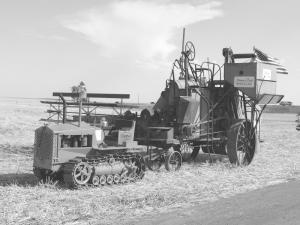2012 - Volume #36, Issue #4, Page #23
[ Sample Stories From This Issue | List of All Stories In This Issue | Print this story
| Read this issue]
Annual Field Day Showcases Antique Combines
 |
“We get a heck of a crowd every year and 5 to 6 combines,” says Guhlke, who started the field day with friend Gene Stuckle. “If the kids don’t see them here, they’ll never know about them. These old pull-type combines did a superb job of threshing, better than any self-propelled today.”
Guhlke, Stuckle and other participants do their best to match up the vintage combines with the crawler tractors common to the time and the region. Guhlke notes that crawler tractors were popular on the region’s farms where fields could have a 30 degree slope.
“Until the late 60’s and early 70’s, everyone in the area farmed with crawlers,” he recalls. “I’ve been on fields where the combine slid down the hill.”
Guhlke’s farm has rolling fields with just enough slope to show off the auto-leveling devices most of the combines are equipped with. Several even have the older, mechanical leveling system.
“One year a man in his late 70’s rode in on a motorcycle with some friends,” recounts Guhlke. “He was R.A. (Ray) Hanson, the inventor of the automatic leveling device for combines. He came back the next day and encouraged us to get the levelers fixed.”
After World War II, Hanson had adapted crude autopilot technology to combines, selling them door-to-door with a lifetime guarantee. The inventor later became internationally known for his engineering innovations.
“He told us the lifetime guarantee was still good if we had problems,” laughs Guhlke.
The field day first started with a single combine, one Stuckle had stored in his shed. At Guhlke’s urging, it was pulled out, restored and put to use on Guhlke’s farm alongside Highway 2, west of Spokane.
“We didn’t advertise it, but we drew a crowd,” recalls Guhlke.
Participants spend about a month each year getting the combines ready for the field day. This past summer the units in use included a Harris 30-38 (30-in. wide cylinder; 38-in. wide separator) pulled by an HD11 Allis Chalmers crawler tractor. Guhlke explained that the 30-38 was the largest capacity pull-type built at one time and was used throughout the Pacific Northwest.
Other units at work included a 36B Deere pulled by an RD7 Cat crawler; a Case V2 pulled by a 9UD6 Cat; a 1936 galvanized McCormick Deering pulled by a Cletrac; and a 51 McCormick Deering pulled by an RD6. Vintage trucks from the 1940’s and 1950’s are on hand to haul away the grain.
“These combines could harvest from 1,000 to 1,200 bushels of wheat a day,” says Guhlke, who ran one up until 1960. “The superior threshing was due to a second sieve called a reclean sieve. One year the wheat was rained on, and the local elevator manager was afraid our field day wheat would be bad. Even with the rain, the combines produced #1 grain with no trash and no problems.”
For those wishing to see the field days, they are always held the last Saturday and Sunday of August. A fundraising dinner requiring advance tickets is held on Saturday night.
“This year a calendar was made up with pictures from the 2011 field day,” says Guhlke. “It’s priced at $30, and like the dinner, profits go to the Lincoln County Historical Museum.”
Contact: FARM SHOW Followup, Lincoln County Historical Museum, P.O. Box 585, 600 7th St., Davenport, Wash. 99122 (ph 509 725-6711); or Crayton C. Guhlke, P.O. Box 1272, Davenport, Wash. 99122 (ph 509 721-0130; crayton@centurytel.net).

Click here to download page story appeared in.

Click here to read entire issue
To read the rest of this story, download this issue below or click here to register with your account number.




